Gold Price BOOM!
Commodities / Gold and Silver 2014 Jan 28, 2014 - 12:00 PM GMTBy: John_Mauldin
 By Grant Williams
By Grant Williams
"What a year this has been for gold.
"The price of the yellow metal fell almost 30% from its peak at the end of August a year earlier, to bombed-out lows amidst a wall of selling which included several very sharp and somewhat counterintuitive selloffs, including violent plunges in both the April-May time frame and again into year-end.
"Throughout the year, the spectre of manipulation was never far from the minds of all those involved in the gold market, whether they were crying 'foul' or asserting that, of course, there was no manipulation whatsoever and that those who suggested there might be were nothing more than conspiracy theorists, kooks, and whackos.
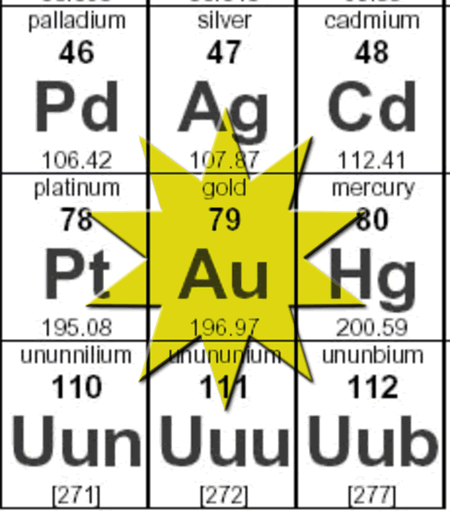
"The main suspects at the heart of the conspiracy theories were, naturally, the bullion banks and the central banks.
"The bullion banks, of course, have the eternal motive: profit; but what possible reason could central banks have for suppressing the price? None whatsoever, of course. The gold market is too small and too inconsequential for them to take an interest.
"And yet, rumours abounded that the bullion banks were in dire trouble and that a rising gold price could send one or more of them over the edge and into insolvency as a scramble for physical metal exposed massive short positions that had grown out of a fractional-reserve-based lending system backed (if not explicitly, then certainly complicitly) by central banks..."
Now THAT, you may well have thought, was the heart-racking, pulse-pounding introduction to my year-end look at the gold market. No preamble, no carefully constructed narrative to entice you into my latest little web, just BOOM! Straight into it.
And every word of the above makes sense based upon what we've seen happen in the past twelve months in the topsy-turvy world of element 79, which holds down the spot in the periodic table just after platinum and just before mercury.
But of course, nothing is what it seems when we are discussing gold.
That quotation at the top is the intro to the year-end review of gold that I would have written in 1999 ... had I been doing such things back then.
2013 was, in many ways, a case of been there, done that; and to understand what is happening today, it is extremely instructive to go back to 1999 and reexamine some very strange goings-on at the UK Treasury, AIG, Rothschild, Goldman Sachs, and Number 11 Downing Street.
(Cue dreamy harp music.)
The chart of the gold price between February 1996 and August 1999 will look eerily familiar to anybody who follows the gold market closely; and for those who don't, just stick around and I'll show you what you've been missing.
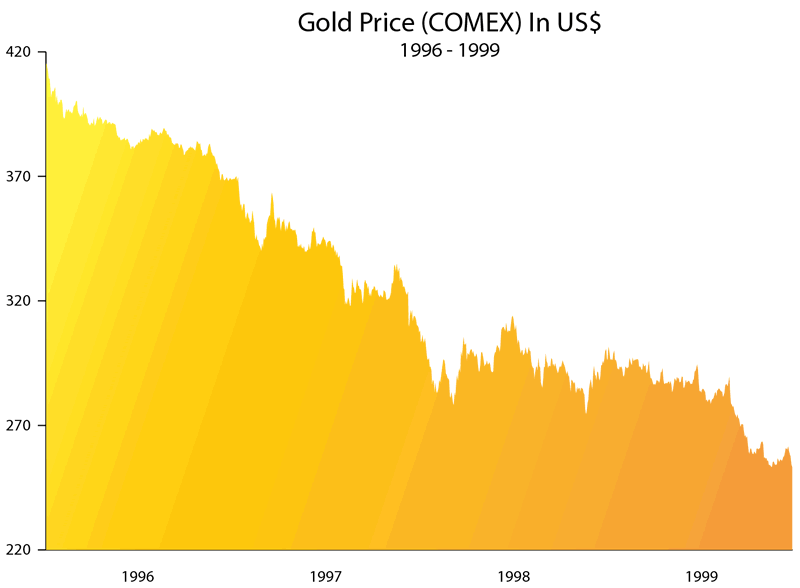
Source: Bloomberg
After a run-up to a spike-high of $415.50 on February 2, 1996, gold began to fall. It fell fairly quickly at first, losing 3% in six trading sessions; and then the decline steadied for a while but remained consistent — until, around the end of the calendar year, gold suddenly and inexplicably spiked straight down. By the end of 1996, it had lost 11% of its value.
As 1996 turned into 1997 the price continued to fall; and the new year saw several inexplicable downdrafts of considerable size and alarming speed which, by the time the dust had settled at midnight on December 31st, 1997, had cut the value of an ounce of gold by almost a quarter.
Gold market watchers were baffled at the continued weakness in their beloved metal. They bemoaned their bad fortune and pleaded with the gods above, but neither activity made any difference — the price continued to fall. (Sound familiar?)
1998 was a fairly stable year, with the price moving little from January to December (though again, during the year there were several large falls in price that were hard to account for); and as the world entered the last year of the millennium, there was an air of stability around gold that gave hope to those battered by the consistent weakness in the gold price.
(To reiterate, I am talking about the late 1990s here, NOT the last couple of years — just in case there was any confusion.)
On the last day of 1998, gold closed at $288.25, down from $415.50 on February 2, 1996 — a fall of over 30% in three years.
You ... yes, you with the glasses at the back...
(muffled question)
No, there is very little similarity to the 37% decline in the gold price from the August 2011 high to the close on December 31, 2013.
(muffled question)
What do I MEAN? Well, obviously, any similarity is completely coincidental because there were a number of strange things happening and rumours swirling back in 1998 about bullion banks being short gold in quantities that posed a risk to them and, of course, to "the system" — whatever THAT means — so those were once in a lifetime circumstances.
(muffled retort)
Well, yes, I suppose, now that you mention THAT, there MAY be some purely coincidental similarities between the two periods, but when you hear what happened next, you'll realize that the time I'm talking about was nothing like today, because the following year (1999) a certain central bank did something quite bizarre that led directly to sharply lower gold prices and a dramatic increase in specula...
(muffled retort)
... oh look, stop it now. Keep your Bundesbank tale under your hat and we'll discuss it when I've finished. We need to get back to the main story.
If I may? Thank you.
So, as I was saying before I was rudely interrupted by young Eric there, 1999 dawned with an awful lot of antipathy towards gold after three years of poor performance. The rumour mill was operating overtime as speculation about large shorts in physical metal moved towards a crescendo, and a group of central bankers either dismissed accusations of any involvement in price suppression or refused to discuss it at all.
The first five months of 1999 looked fairly familiar to anybody who happened to keep a watchful eye on the gold market.
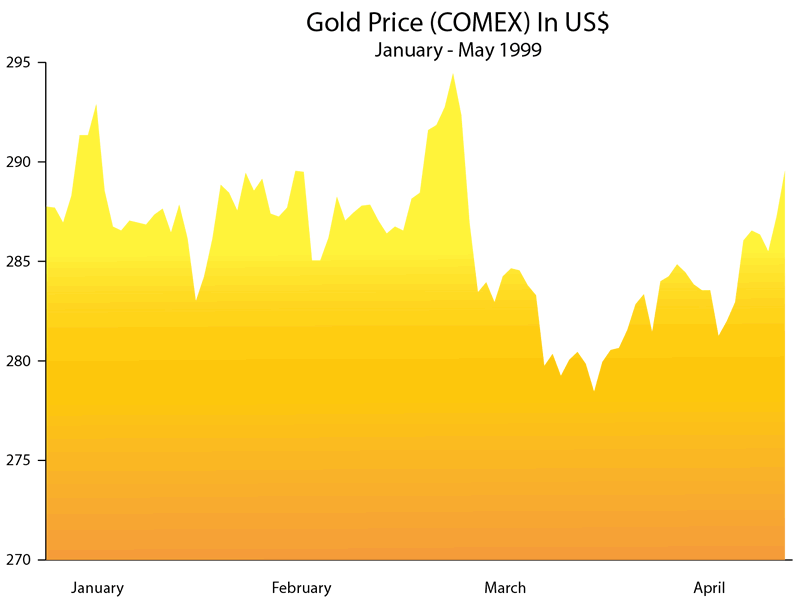
Source: Bloomberg
After three poor years, gold was scratching around trying to find a bottom, and it looked like it was succeeding. The path of least resistance was clearly upward, and it looked for all the world as though a bounce was in the cards, since sellers had become exhausted.
The gold price saw several quick spikes — all of which were followed immediately by sharp selloffs; but the net result was that on May 6, 1999, the gold price stood a fraction above where it had entered the year.
It was at this point that things started to get screwy.
The next day, May 7, 1999, then-Chancellor of the UK Exchequer, Gordon Brown, announced that he would sell almost 400 tons of Britain's gold reserves in a series of auctions over the subsequent three-year period. Dates of those auctions were to be set well in advance.
Tense?
No, I don't mean "Are you on the edge of your seat?" The "tense" I am questioning is that used by Brown in his announcement — it was, in this case, the future progressive.
Ordinarily, when people like Brown make statements, they use a tense exclusively reserved for use by government officials and those heading up the world's major central banks: the future promissory.
This tense is constructed by taking an intended possibility and removing the words we hope and pray from the beginning of the sentence and inserting the word will in the middle.
Let me give you an example. When using the future promissory tense, the phrase "We hope and pray interest rates remain low until at least 2016" becomes:
"Interest rates will remain low until 2016."
Likewise, "We hope and pray we can unwind QE without any problems" becomes
"We will unwind QE without any problems."
Try it yourselves.
Anyway, Brown's use of the future progressive tense was particularly bizarre, because anybody who knows anything about finance, and particularly about the purchase and sale in large quantities of a price-sensitive commodity, knows that you do NOT telegraph to the market what your intentions are, because the market will then front-run you and sell that commodity short in order to generate themselves a nice healthy profit (with every dime of that profit coming directly out of the seller's proceeds).
Now, I may have been a bit naive here, but for the longest time I thought the entire set of "central bankers & treasury officials'" was a subset contained within the set of "people who understand a little about finance."
Thanks to John Venn, we can express the harsh reality rather simply:

Anyway, following Brown's extraordinary statement, I'm sure all those of you who reside firmly in the left-hand circle of that diagram can guess what happened next:
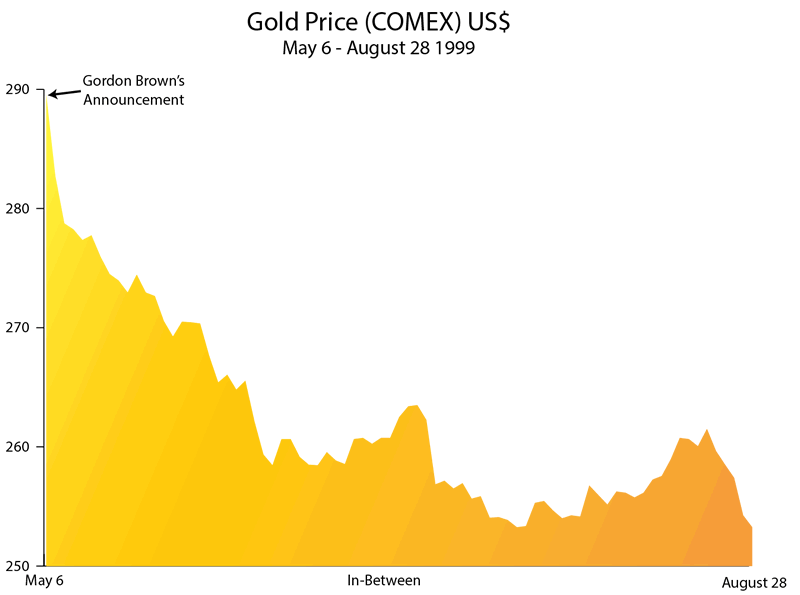 Source: Bloomberg
Source: Bloomberg
Yup! As anybody with even a rudimentary grasp of market dynamics could have predicted, the gold price fell off a cliff ... and kept on falling.
Thomas Pascoe of the UK Daily Telegraph took up the story (several years later, after a battle with the UK government over a series of Freedom of Information requests); and I have to say that for a mainstream media journalist, he did a damned fine job:
(UK Daily Telegraph, June 2012): One decision [of Brown's] stands out as downright bizarre, however: the sale of the majority of Britain's gold reserves for prices between $256 and $296 an ounce, only to watch it soar so far as $1,615 per ounce today.
When Brown decided to dispose of almost 400 tonnes of gold between 1999 and 2002, he did two distinctly odd things.
First, he broke with convention and announced the sale well in advance, giving the market notice that it was shortly to be flooded and forcing down the spot price. This was apparently done in the interests of "open government", but had the effect of sending the spot price of gold to a 20-year low, as implied by basic supply and demand theory.
Second, the Treasury elected to sell its gold via auction. Again, this broke with the standard model.
The price of gold was usually determined at a morning and afternoon "fix" between representatives of big banks whose network of smaller bank clients and private orders allowed them to determine the exact price at which demand met with supply.
The auction system again frequently achieved a lower price than the equivalent fix price. The first auction saw an auction price of $10c less per ounce than was achieved at the morning fix. It also acted to depress the price of the afternoon fix which fell by nearly $4.
Then, Pascoe dropped the hammer:
It seemed almost as if the Treasury was trying to achieve the lowest price possible for the public's gold. It was.
We'll come back to Pascoe's article a little later, but in the meantime it's back to 1999 and the rumour mill...
There was consternation in the gold community and anguished cries that, as usual, there was a vast conspiracy in play here. Those rumours of large shorts held by a couple of big players in the bullion market just wouldn't go away, but nobody could quite put their finger on what was going on — although a couple of slightly curious names were being whispered in the gold pits: AIG (remember them?) and NM Rothschild.
Brown's series of auctions over the following three years emptied most of the UK's gold from the Bank of England's vaults, depressed the price to levels previously unthought of and, according to those of a more conspiratorial mindset, achieved something else. Something hidden, something unknown.
But what?
The probable answer wouldn't begin to appear from amidst the fog until mid-2004, when, a couple of months apart, a couple of very quiet and matter-of-fact announcements were made, which we will get to shortly. In the meantime, if the UK Treasury was trying to achieve the lowest possible price for its gold, it was doing admirably — right up until September 26, 1999, when a backlash against Brown's actions crystallized in Washington DC through the signing of the Washington Agreement on Gold.
(Wikipedia): Under the agreement, the European Central Bank (ECB), the 11 national central banks of nations then participating in the new European currency, plus those of Sweden, Switzerland and the United Kingdom, agreed that gold should remain an important element of global monetary reserves and to limit their sales to no more than 400 tonnes (12.9 million oz) annually over the five years September 1999 to September 2004, being 2,000 tonnes (64.5 million oz) in all.
The agreement came in response to concerns in the gold market after the United Kingdom treasury announced that it was proposing to sell 58% of UK gold reserves through Bank of England auctions, coupled with the prospect of significant sales by the Swiss National Bank and the possibility of on-going sales by Austria and the Netherlands, plus proposals of sales by the IMF.
The UK announcement, in particular, had greatly unsettled the market because, unlike most other European sales by central banks in recent years, it was announced in advance. Sales by such countries as Belgium and the Netherlands had always been discreet and announced after the event. So the Washington/European Agreement was at least perceived as putting a cap on European sales.
So that's clear. What is interesting are the criticisms of the agreement, as posted on the same Wikipedia page:
•The agreement is not an international treaty, as defined and governed by international law.
•The agreement is a sui generis, gentlemen's agreement among Central Bankers, of doubtful legality given the objectives and public law nature of Central Banks.
•The agreement resembles a cartel that materially affects the supply of gold in the global market. In this regard, the agreement stretches the borders of antitrust legislation.
•The agreement was negotiated behind closed doors. Information was not provided to the public and relevant stakeholders were not afforded the opportunity to comment.
•The agreement does not contain formal mechanisms for re-negotiation. Trends in international law regarding public participation and access to information should inform the re-negotiation process, scheduled for 2004.
Sounds pretty much par for the course, if you ask me; but that's the world we've allowed to be created by the governments and central banks of the world while we watch American Idol.
Anyway, with Brown's sales well and truly underway and the market price suitably depressed, the announcement from Washington caused a small problem. Limiting sales of a commodity has the opposite effect to the pre-announced sales by the UK Treasury, and the inevitable ensued.
The gold price, freed temporarily from the shackles of the huge overhang Brown had created, soared, as you can see from the chart below:
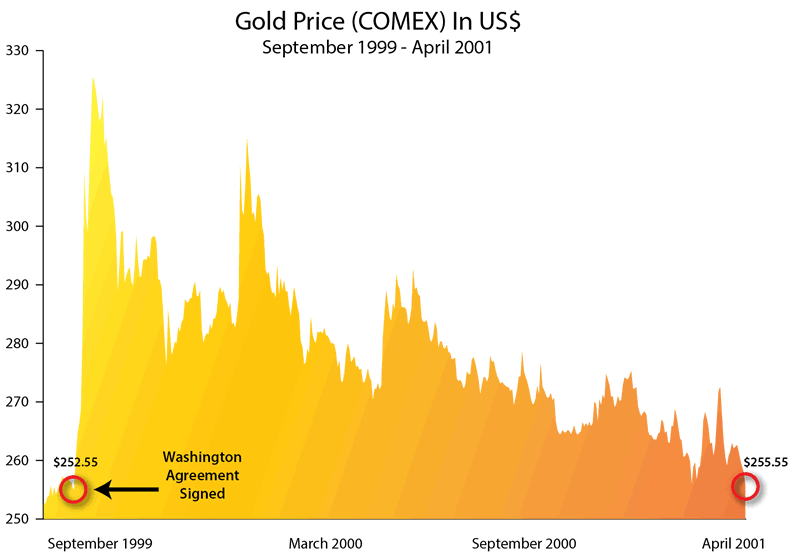
Source: Bloomberg
...and that — assuming the rumours were correct and there were a couple of entities short a lot of gold and looking to cover into a falling price — created another big problem.
The post-Washington Agreement spike would have caused severe problems for anybody short gold, and if those problems caused any kind of systemic risk, then they were problematic for central banks and governments, too.
Of course, all this was nothing more than conjecture ... at the time.
BUT several years later a conversation surfaced that had involved Bank of England Governor Eddie George, shortly after the Washington agreement was signed in 1999. Whereupon many of the doubts surrounding the motives behind the strange doings in the gold markets disappeared like my buddy Whipper West 20 seconds before the bar tab is presented:
(Jesse's Café Américain): In front of 3 witnesses, Bank of England Governor Eddie George spoke to Nicholas J. Morrell (CEO of Lonmin Plc) after the Washington Agreement gold price explosion in Sept/Oct 1999. Mr. George said "We looked into the abyss if the gold price rose further. A further rise would have taken down one or several trading houses, which might have taken down all the rest in their wake.
Therefore at any price, at any cost, the central banks had to quell the gold price, manage it. It was very difficult to get the gold price under control but we have now succeeded. The US Fed was very active in getting the gold price down. So was the U.K.
You want to find a smoking gun at the crime scene? Well this one has fingerprints on it and the words "Eddie George, Governor of the Bank of England" carved into the butt.
Case closed. Except...
With none of this ever having been officially acknowledged, the whole business has juuuuust enough uncertainty surrounding it to enable those who don't want to know to put their fingers in their ears and repeat "la-la-la-la-la."
As you can see from the chart above, the following 18 months saw the gold price "managed" steadily lower, despite several large spikes in price as the natural forces of supply and demand threatened to overrun the Bank of England — and US Federal Reserve-led intervention.
Eventually, enough force was brought to bear to get the gold price back to its pre-Washington Agreement level. This was in large part due to the sales by Brown of the UK's gold stash. When the smoke had cleared and the auctions were completed, Brown's Treasury conducted an autopsy review of the process that would end up costing the UK taxpayer roughly ₤17 bn in lost profits at gold's peak in 2011, and even in the immediate aftermath a cool ₤175 mn.
That review was bound to be scathing, right? Wrong:
(UK Daily Telegraph): Chancellor Gordon Brown and his Treasury officials have used an internal review to pat themselves on the back for selling more than half of Britain's gold reserves, despite the fact the process lost the taxpayer around £175m.
Huh? Say what?
The news that one of the world's major central banks was selling its reserves contributed to a collapse in the gold price which was a serious blow to the market.
However, the Treasury argues that the auction was a great success. Its review, which has been published on an obscure part of the Treasury website, claims: "The UK Government's sales programme has clearly demonstrated that auctions provide a transparent and fair method for selling gold and similar types of asset."
Oh come ON!! Really?!
I know government officials have a predilection for trying the Jedi Mind Trick on us, but this is utterly ridiculous.
Luckily, not everybody was fooled:
Peter Hambro, who runs the eponymous gold company, said: "The idea the auction was a success is completely ridiculous. The point is the Treasury called the bottom of the market with uncanny accuracy. They have forgotten that gold is meant for times of trouble."
Amazingly (though this is government we are talking about here, so the bar over which one has to hurdle to be classified as "amazing" is lower than Kim Kardashian's level of self-respect), despite the fact that the price fell to a 20-year low after the auction process was announced and then soared 30% after its conclusion, the Treasury claimed success based solely upon the fact that "on average, they achieved a price within 75 cents, or 0.3pc, of the market price."
I'm sorry, but when you conduct sales like that, you SET the market price. Idiots.
The article continues:
The review states: "It is not apparent from the data that the market was systematically depressing the price of gold in the run-up to the auctions. Nor is there any evidence that the price of gold systematically rose following the auctions."
Not apparent? To WHOM?? As for evidence that the price of gold systematically rose following the auctions, I would suggest looking at ...... the price!
IDIOTS.
The Bank of England sold 395 tonnes of gold, raising about $3.5 billion. The money has since been invested in euros, yen and dollars as a way of diversifying risk.
The review concludes: "Above all, the programme successfully delivered a one-off and permanent reduction in risk on the net reserves as a result of the better diversification achieved."
It's just too painful to listen to sometimes.
To continue reading this article from Things That Make You Go Hmmm… – a free weekly newsletter by Grant Williams, a highly respected financial expert and current portfolio and strategy advisor at Vulpes Investment Management in Singapore – please click here.
Like Outside the Box?
Sign up today and get each new issue delivered free to your inbox.
It's your opportunity to get the news John Mauldin thinks matters most to your finances.
© 2013 Mauldin Economics. All Rights Reserved.
Outside the Box is a free weekly economic e-letter by best-selling author and renowned financial expert, John Mauldin. You can learn more and get your free subscription by visiting www.MauldinEconomics.com.
Please write to subscribers@mauldineconomics.com to inform us of any reproductions, including when and where copy will be reproduced. You must keep the letter intact, from introduction to disclaimers. If you would like to quote brief portions only, please reference www.MauldinEconomics.com.
To subscribe to John Mauldin's e-letter, please click here: http://www.mauldineconomics.com/subscribe
To change your email address, please click here: http://www.mauldineconomics.com/change-address
Outside the Box and MauldinEconomics.com is not an offering for any investment. It represents only the opinions of John Mauldin and those that he interviews. Any views expressed are provided for information purposes only and should not be construed in any way as an offer, an endorsement, or inducement to invest and is not in any way a testimony of, or associated with, Mauldin's other firms. John Mauldin is the Chairman of Mauldin Economics, LLC. He also is the President of Millennium Wave Advisors, LLC (MWA) which is an investment advisory firm registered with multiple states, President and registered representative of Millennium Wave Securities, LLC, (MWS) member FINRA, SIPC, through which securities may be offered . MWS is also a Commodity Pool Operator (CPO) and a Commodity Trading Advisor (CTA) registered with the CFTC, as well as an Introducing Broker (IB) and NFA Member. Millennium Wave Investments is a dba of MWA LLC and MWS LLC. This message may contain information that is confidential or privileged and is intended only for the individual or entity named above and does not constitute an offer for or advice about any alternative investment product. Such advice can only be made when accompanied by a prospectus or similar offering document. Past performance is not indicative of future performance. Please make sure to review important disclosures at the end of each article. Mauldin companies may have a marketing relationship with products and services mentioned in this letter for a fee.
Note: Joining The Mauldin Circle is not an offering for any investment. It represents only the opinions of John Mauldin and Millennium Wave Investments. It is intended solely for investors who have registered with Millennium Wave Investments and its partners at http://www.MauldinCircle.com (formerly AccreditedInvestor.ws) or directly related websites. The Mauldin Circle may send out material that is provided on a confidential basis, and subscribers to the Mauldin Circle are not to send this letter to anyone other than their professional investment counselors. Investors should discuss any investment with their personal investment counsel. You are advised to discuss with your financial advisers your investment options and whether any investment is suitable for your specific needs prior to making any investments. John Mauldin is the President of Millennium Wave Advisors, LLC (MWA), which is an investment advisory firm registered with multiple states. John Mauldin is a registered representative of Millennium Wave Securities, LLC, (MWS), an FINRA registered broker-dealer. MWS is also a Commodity Pool Operator (CPO) and a Commodity Trading Advisor (CTA) registered with the CFTC, as well as an Introducing Broker (IB). Millennium Wave Investments is a dba of MWA LLC and MWS LLC. Millennium Wave Investments cooperates in the consulting on and marketing of private and non-private investment offerings with other independent firms such as Altegris Investments; Capital Management Group; Absolute Return Partners, LLP; Fynn Capital; Nicola Wealth Management; and Plexus Asset Management. Investment offerings recommended by Mauldin may pay a portion of their fees to these independent firms, who will share 1/3 of those fees with MWS and thus with Mauldin. Any views expressed herein are provided for information purposes only and should not be construed in any way as an offer, an endorsement, or inducement to invest with any CTA, fund, or program mentioned here or elsewhere. Before seeking any advisor's services or making an investment in a fund, investors must read and examine thoroughly the respective disclosure document or offering memorandum. Since these firms and Mauldin receive fees from the funds they recommend/market, they only recommend/market products with which they have been able to negotiate fee arrangements.
PAST RESULTS ARE NOT INDICATIVE OF FUTURE RESULTS. THERE IS RISK OF LOSS AS WELL AS THE OPPORTUNITY FOR GAIN WHEN INVESTING IN MANAGED FUNDS. WHEN CONSIDERING ALTERNATIVE INVESTMENTS, INCLUDING HEDGE FUNDS, YOU SHOULD CONSIDER VARIOUS RISKS INCLUDING THE FACT THAT SOME PRODUCTS: OFTEN ENGAGE IN LEVERAGING AND OTHER SPECULATIVE INVESTMENT PRACTICES THAT MAY INCREASE THE RISK OF INVESTMENT LOSS, CAN BE ILLIQUID, ARE NOT REQUIRED TO PROVIDE PERIODIC PRICING OR VALUATION INFORMATION TO INVESTORS, MAY INVOLVE COMPLEX TAX STRUCTURES AND DELAYS IN DISTRIBUTING IMPORTANT TAX INFORMATION, ARE NOT SUBJECT TO THE SAME REGULATORY REQUIREMENTS AS MUTUAL FUNDS, OFTEN CHARGE HIGH FEES, AND IN MANY CASES THE UNDERLYING INVESTMENTS ARE NOT TRANSPARENT AND ARE KNOWN ONLY TO THE INVESTMENT MANAGER. Alternative investment performance can be volatile. An investor could lose all or a substantial amount of his or her investment. Often, alternative investment fund and account managers have total trading authority over their funds or accounts; the use of a single advisor applying generally similar trading programs could mean lack of diversification and, consequently, higher risk. There is often no secondary market for an investor’s interest in alternative investments, and none is expected to develop.
John Mauldin Archive |
© 2005-2022 http://www.MarketOracle.co.uk - The Market Oracle is a FREE Daily Financial Markets Analysis & Forecasting online publication.



